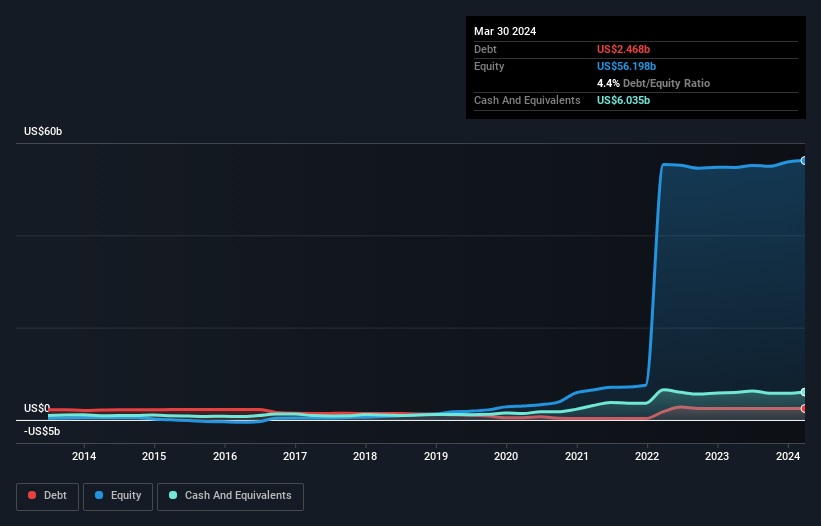Is Advanced Micro Devices (NASDAQ:AMD) A Risky Investment?
Some say volatility, rather than debt, is the best way to think about risk as an investor, but Warren Buffett famously said that 'Volatility is far from synonymous with risk.' When we think about how risky a company is, we always like to look at its use of debt, since debt overload can lead to ruin. We note that Advanced Micro Devices, Inc. (NASDAQ:AMD) does have debt on its balance sheet. But is this debt a concern to shareholders?
Why Does Debt Bring Risk?
Debt is a tool to help businesses grow, but if a business is incapable of paying off its lenders, then it exists at their mercy. In the worst case scenario, a company can go bankrupt if it cannot pay its creditors. However, a more usual (but still expensive) situation is where a company must dilute shareholders at a cheap share price simply to get debt under control. Of course, debt can be an important tool in businesses, particularly capital heavy businesses. The first thing to do when considering how much debt a business uses is to look at its cash and debt together.
Check out our latest analysis for Advanced Micro Devices
How Much Debt Does Advanced Micro Devices Carry?
The chart below, which you can click on for greater detail, shows that Advanced Micro Devices had US$2.47b in debt in March 2024; about the same as the year before. However, its balance sheet shows it holds US$6.04b in cash, so it actually has US$3.57b net cash.
How Healthy Is Advanced Micro Devices' Balance Sheet?
Zooming in on the latest balance sheet data, we can see that Advanced Micro Devices had liabilities of US$6.47b due within 12 months and liabilities of US$5.22b due beyond that. On the other hand, it had cash of US$6.04b and US$5.07b worth of receivables due within a year. So its liabilities total US$593.0m more than the combination of its cash and short-term receivables.
Having regard to Advanced Micro Devices' size, it seems that its liquid assets are well balanced with its total liabilities. So while it's hard to imagine that the US$277.4b company is struggling for cash, we still think it's worth monitoring its balance sheet. While it does have liabilities worth noting, Advanced Micro Devices also has more cash than debt, so we're pretty confident it can manage its debt safely.
Even more impressive was the fact that Advanced Micro Devices grew its EBIT by 203% over twelve months. That boost will make it even easier to pay down debt going forward. The balance sheet is clearly the area to focus on when you are analysing debt. But ultimately the future profitability of the business will decide if Advanced Micro Devices can strengthen its balance sheet over time. So if you want to see what the professionals think, you might find this free report on analyst profit forecasts to be interesting.
Finally, a company can only pay off debt with cold hard cash, not accounting profits. Advanced Micro Devices may have net cash on the balance sheet, but it is still interesting to look at how well the business converts its earnings before interest and tax (EBIT) to free cash flow, because that will influence both its need for, and its capacity to manage debt. Over the last three years, Advanced Micro Devices actually produced more free cash flow than EBIT. That sort of strong cash conversion gets us as excited as the crowd when the beat drops at a Daft Punk concert.
Summing Up
We could understand if investors are concerned about Advanced Micro Devices's liabilities, but we can be reassured by the fact it has has net cash of US$3.57b. And it impressed us with free cash flow of US$1.2b, being 149% of its EBIT. So is Advanced Micro Devices's debt a risk? It doesn't seem so to us. When analysing debt levels, the balance sheet is the obvious place to start. But ultimately, every company can contain risks that exist outside of the balance sheet. For example, we've discovered 1 warning sign for Advanced Micro Devices that you should be aware of before investing here.
If you're interested in investing in businesses that can grow profits without the burden of debt, then check out this free list of growing businesses that have net cash on the balance sheet.
Have feedback on this article? Concerned about the content? Get in touch with us directly. Alternatively, email editorial-team (at) simplywallst.com.
This article by Simply Wall St is general in nature. We provide commentary based on historical data and analyst forecasts only using an unbiased methodology and our articles are not intended to be financial advice. It does not constitute a recommendation to buy or sell any stock, and does not take account of your objectives, or your financial situation. We aim to bring you long-term focused analysis driven by fundamental data. Note that our analysis may not factor in the latest price-sensitive company announcements or qualitative material. Simply Wall St has no position in any stocks mentioned.

 Yahoo Finance
Yahoo Finance 
